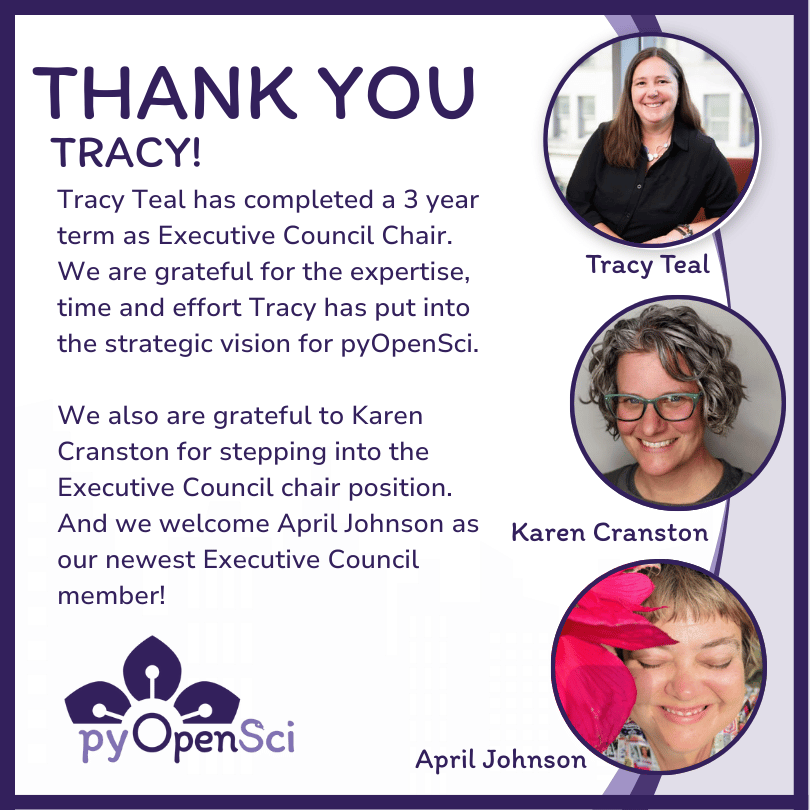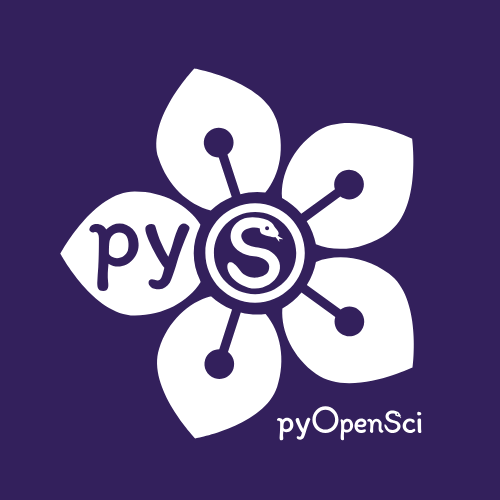When an organization successfully navigates its first leadership transition, it’s a milestone worth celebrating. It demonstrates that the structures, processes, and culture you’ve built are strong enough to endure beyond any single individual. We’ve seen these transitions happening in our Editorial Board over the past 3 years. Today, we’re proud to announce pyOpenSci’s first Executive Council transition—a sign of our organization’s growth and maturity.

As founding Executive Council Chair Tracy Teal transitions from her leadership role after three transformative years, we’re excited to welcome Karen Cranston as our new Executive Council Chair and April Johnson as a new Executive Council member. This transition represents not just changing leadership, but the successful maturation of pyOpenSci as an organization.
From grassroots vision to established organization
pyOpenSci began in 2018 as a passion project born from engagement in the Python, open source community. As a volunteer who deeply cared about scientific open source software, I saw numerous pain points in how the Python scientific community approached software quality and sustainability. We brought together a small group of like-minded open source leaders to pilot what peer review of scientific Python software could look like—creating something that didn’t exist but was clearly needed.
Five years later, our grassroots effort had evolved into something much larger. In 2022, with Sloan Foundation funding secured, we transitioned to fiscal sponsorship under the 501(c)(3) fiscal host, Community Initiatives, establishing pyOpenSci as an independent, fiscally-sponsored project. This transition marked our transformation from a purely volunteer-driven initiative to a structured organization with formal governance, funding, and accountability structures.
Building strong governance: The Executive Council’s role
The pyOpenSci Executive Council was founded in 2022 as the cornerstone of our governance structure. The Council provides strategic oversight, organizational guidance, and accountability while serving as ambassadors for our mission and as a support system for our Executive Director. Working alongside our Advisory Council, which offers domain-specific expertise, this governance structure has been instrumental in our steady growth.
Three years of shared accomplishments
Under Tracy’s leadership as our founding Executive Council (EC) Chair, the EC has achieved remarkable milestones over the past three years. Together, we:
- Established our foundational identity: Crafted a powerful mission while directing the vision and values of our organization that guide our work together.
- Built robust governance structures: Created transparent decision-making processes and accountability mechanisms.
- Fostered a healthier and inclusive community: Implemented a comprehensive code of conduct with clear procedures that support inclusive community engagement.
- Secured sustainable funding: We have also secured over $1,000,000 in funding while building relationships for future support.
These achievements reflect the successful synergy between Executive Council members who brought diverse expertise in nonprofit management, open source communities, and scientific software development to guide our strategic direction.
Celebrating transition: a sign of success
Three years into our journey as an independent organization, this Executive Council transition marks a milestone we’re celebrating as a symbol of organizational maturity and success.
Tracy’s non profit leadership experience, strategic vision and steady guidance have been foundational to everything we’ve accomplished—from establishing our governance structures to guiding us through the critical early years of organizational development. As she transitions from her EC Chair role, we’re deeply grateful for the strong foundation she’s helped build.
Karen Cranston will continue to serve on the pyOpenSci leadership team, moving into the role of EC Chair. Karen brings extensive experience in open science, having served in leadership roles at organizations such as The Carpentries and the Open Bioinformatics Foundation that bridge community, research and data science. Karen’s deep understanding of both the scientific community and organizational development makes her ideally suited to guide pyOpenSci through our next phase of growth.
We’re also thrilled to welcome April Johnson to our Executive Council. April brings invaluable expertise as a technology executive and consultant to humanities and civil rights nonprofits, most recently as People Lead at 2i2c and as Board Chair for He She Ze & We. Her experience in organizational development and people-centered leadership will be crucial as we continue to scale our community, work on sustainability, and impact.
What this maturity enables
This successful transition demonstrates that pyOpenSci has evolved into a growing, sustainable organization. Succession is success as it demonstrates that we’ve built something larger than any individual contributor—with proven governance structures, institutional knowledge, and a thriving community that transcends leadership changes.
As we move forward under Karen and April’s guidance, we’re excited about our next chapter. This includes a strategic focus on sustainability—thoughtfully considering how we generate revenue as an organization, and ways we can scale that also support long-term sustainability. We’re also exploring deeper collaborations with aligned communities like rOpenSci, PREreview, The Carpentries, and Open Life Science.
This transition positions us to take on bigger challenges, expand our impact on the scientific Python ecosystem, and continue building the future of open scientific software. We can’t wait to see what comes next!
Connect with us!
There are lots of ways to get involved if you are interested!
- If you read through our lessons and want to suggest changes, open an issue in our lessons repository here.
- Volunteer to be a reviewer for pyOpenSci’s software review process.
- Submit a scientific Python package to pyOpenSci for peer review.
- Donate to pyOpenSci to support scholarships for future training events and the development of new learning content.
- Check out our volunteer page for other ways to get involved.
You can also:
- Keep an eye on our events page for upcoming training events.
Follow us on social platforms:
If you are on LinkedIn, check out and subscribe to our newsletter, too.
Connect with us!
There are many ways to get involved if you’re interested!
- If you read through our lessons and want to suggest changes, open an issue in our lessons repository here
- Volunteer to be a reviewer for pyOpenSci’s software review process
- Submit a Python package to pyOpenSci for peer review
- Donate to pyOpenSci to support scholarships for future training events and the development of new learning content.
- Check out our volunteer page for other ways to get involved.
You can also:
- Keep an eye on our events page for upcoming training events.
Follow us on social platforms:
If you are on LinkedIn, check out and subscribe to our newsletter.
You can also:
- Check out our Python Package Guide for comprehensive packaging guidance
- Keep an eye on our events page for upcoming training events

Leave a comment